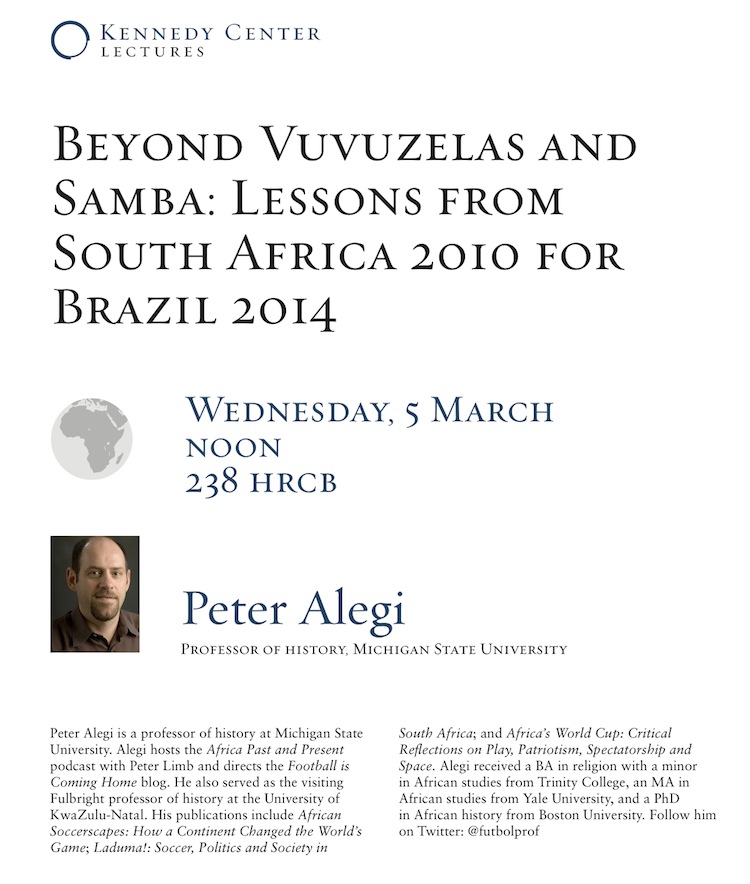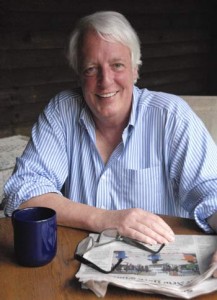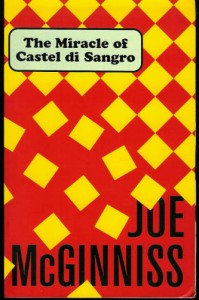This is my video blog contribution to the Football Scholars Forum roundtable taking place on Saturday, April 12, 2014, at the global fútbological conclave known as the Soccer as the Beautiful Game conference at Hofstra University in New York.
These pre-conference blog posts are intended to launch the discussion about points of overlap and tension in the soccer writing of journalists and academics. Roundtable participants will share their insights on sources and methodologies, topics, audience, market logic vs. academic logic, and the role of digital tools in writing and dissemination.
The rest of the roundtable team is composed of Simon Kuper (Financial Times), Brenda Elsey (historian, Hofstra U.) Alex Galarza (Michigan State U.), John Foot (U. Bristol), and Grant Wahl (Sports Illustrated). To read their posts visit: http://footballscholars.org
Month: March 2014

Sunday’s clásico was made for Ray Hudson’s commentary: like a “hair dryer in a hot tub” to use his magisterial description of Iniesta’s opening goal. I was happy with the outcome since I’ve had a soft spot for Barça for a long, long time. It dates back to my older brother in 1977 (or thereabouts) taking me to see Sandro Ciotti’s Il Profeta del Gol—a film about Cruyff with jaw-dropping goals from his azulgrana days. In honor of the Dutch genius, I even wore number 14 in high school and college back when I daydreamed about walking out of the tunnel at Camp Nou to take on Real Madrid.
Given all that, it’s the perfect time to review Sid Lowe’s Fear and Loathing in La Liga: Barcelona vs Real Madrid for today’s Football Scholars Forum.
Lowe, as readers of this blog probably know, is a noted fútbol journalist who writes about Spanish football for The Guardian and other major media outlets. He is also a rare sports reporter with a PhD (in History from the University of Sheffield in 2008 with a thesis on “The Juventud de Acción Popular in Spain, 1932-1937”). For a long time the biggest game in the world was not called el clásico but the derbi (p. 18). This book is a gold mine of such futbological facts and statistics. But the most revealing part of the journey, at least for me, came from its analysis and contextualization of the rivalry’s social and political dynamics.
The author’s academic training and sensibility is brought to bear on Fear and Loathing in La Liga in a number of ways. First, the chronological structure of the book. Second, the rich and diverse sources include government documents, minutes of club meetings, newspaper archives, newsreels, and many oral interviews with elderly protagonists, famous players, and club directors. (Regrettably, the commercial publisher decided to present the book without citations, probably for fear of alienating general readers.) Third, the book situates the fútbol rivalry within the larger context of a changing Spain. Fourth, it eagerly and ably goes beyond simple binaries that simplify the rivalry to just Spain vs. Catalonia, or in Lowe’s words: “Madrid fascists; Barça civil war losers. Madrid civil war victors and repressors; Barça left, Madrid right; Barça good, Madrid bad” (p. 12).
Lowe deploys the historian’s literary device of the potted biography to both complicate the facile dichotomy and to humanize his story. Two brilliant early chapters, for instance, focus on Barça and Madrid presidents during the civil war: Josep Sunyol (“The Martyr President”) and Rafael Sánchez Guerra (“The Forgotten President”). Having examined the historical evidence, Lowe debunks part of the political mythology of Barcelona. He reminds us that Madrid was where the civil war was fought, not Barcelona and argues persuasively that Franco’s forces murdered Sunyol not because he was Barça’s president “but because he accidentally crossed the front line and represented the Republic.” The story of Madrid’s president during the war, Rafael Sánchez Guerra, “a democrat, a liberal . . . committed to the Republic” (p. 39) arrested and tried by the Franco regime, serves as a useful counterpoint to the better known role of Santiago Bernabeu, the right-wing patriarch of Real Madrid during the Franco era.
The 1950s, the book shows, were a golden era for both the clubs and the rivalry itself. With the construction of Bernabeu stadium and Camp Nou, Barça and Madrid had grandiose stages for the performances of their newly arrived superstars: László Kubala (Hungary) and Alfredo Di Stéfano (Argentina), respectively. Camp Nou was the “House that László Built” (see pp. 97, 102-03) and his team’s wonderful success at the time motivated Bernabeu to sign Di Stefano. One of the book’s revelations, based on fascinating hard evidence, is the extent to which Barça’s dithering and doubt, as much as pressure from the Franco regime, led Di Stefano to Madrid. This was a crucial episode in the making of the rivalry as the Blond Arrow’s Dream Team (Puskas, Gento, Kopa, Del Sol, Santamaria . . .) went on to win the first five European Cups!
After Barcelona knocked Madrid out of the 1960-61 European Cup, the rivalry entered a “dark era” that ended with the arrival of Johan Cruyff on the eve of the Franco regime’s demise. The long 1960s are remembered for Real Madrid becoming cultural ambassadors of the dictatorship (though players had little choice in this) as well as for the infamous Copa del Generalissimo quarterfinal of 1970 when referee José Guruceta gifted visiting Madrid a penalty that eliminated the hosts. Guruceta’s match report describes 30,000 cushions thrown on to the pitch; his name, Lowe writes, “became Catalan shorthand for every referee in Spain, shorthand for injustice. For some, he had become shorthand for the football authorities, for Real Madrid and for the dictatorship” (p. 211).
The second half of the book opens with Johan Cruyff’s explosive impact at the Camp Nou in 1973-74. Cruyff’s debut coincided with the appearance of Barca’s slogan “mes que un club” (“More than a club”, now trademarked), which the book notes “did not feel entirely coincidental, football, politics and culture converging” (p. 232). Madrid’s response to the Cruyff-ication of Barca came in the 1980s with the Quinta del Buitre, which succeeded in resurrecting Real’s reputation but failed to win back the trophy that most defines the club: the European Cup.
The final third of the book covers the period from the 1990s to the present. It focuses on how and why Barcelona and Madrid came to dominate European football after 1998. This part is written in a markedly more journalistic style and is less original in its analysis. It is always more difficult for historians to write about contemporary events and avid readers have benefited from English-language books by Phil Ball and Jimmy Burns, among others. Last but not least, the satellite and Internet revolution has made it possible for many of us to closely follow the clásico’s recent history, on and off the pitch. Still, the 406-page book saves some juicy insights for the very end as it considers the impact of the Galacticos, the Special One, the cantera vs. cartera approaches to developing young players (training them vs. buying them), as well as how Spain’s international success has changed both the Barcelona vs. Real Madrid rivalry and fans’ sense of nationhood.
With our memories of Barcelona’s operatic 4-3 comeback victory at the Bernabeu on Sunday still fresh and raw, let us not give in too readily to melancholy or nostalgia. As the closing passage of Fear and Loathing in La Liga puts it: “Real Madrid and Barcelona FC will meet again and when they do the cast will be the most impressive in the game, tickets will sell out in hours and millions will gather in front of television screens across the world, more than for any other club match anywhere. And on the morning of the game they will still be there, clutching flowers, pleading for victory. Once more into the fray. Life in ninety minutes” (p. 409).
Beyond Vuvuzelas and Samba
 Listen to “Beyond Vuvuzelas and Samba: Lessons from South Africa 2010 for Brazil 2014,” a lecture I delivered at Brigham Young University’s David M. Kennedy Center for International Studies on March 5, 2014.
Listen to “Beyond Vuvuzelas and Samba: Lessons from South Africa 2010 for Brazil 2014,” a lecture I delivered at Brigham Young University’s David M. Kennedy Center for International Studies on March 5, 2014.
The talk analyzes the political, economic, and cultural dynamics of the 2010 FIFA World Cup in South Africa and its similarities to the upcoming 2014 FIFA World Cup in Brazil.
Click here to watch the video.
Addio Grande Joe!
 Joe McGinniss had a love affair with soccer.
Joe McGinniss had a love affair with soccer.
The award-winning author and journalist died on March 10, 2014, of prostate cancer at the age of 71 (read an obituary here). I got to know Joe pretty well in the late 1990s while he was writing The Miracle of Castel di Sangro, one of the very first commercially viable books written by an American member of the soccerati class.
I was working on my PhD in African history at Boston University at the time and also teaching a course on “Soccer and Imperialism” at Tufts University. My mother had sent me a Corriere della Sera article about Joe chronicling Castel di Sangro’s 1996-97 serie B season for a David-versus-Goliath book about the team from an Apennine town of 5,000 souls competing just one tier below serie A, then the best league in the world.
As a fútbologist born and raised in Rome, I was naturally intrigued. So I wrote him a concise letter introducing myself and suggesting that given our shared love of calcio it would be nice to meet some time in the near future. Next thing I know Joe got in touch and we met at a Legal Seafoods at Boston’s Logan Airport. He was about to fly back to Italy for what would turn out to be an unexpectedly eventful end to his season in Castel di Sangro.
After the usual pleasantries the talk immediately turned to Italy, football, and especially Roberto Baggio. We reminisced about Baggio’s transcendental play at the 1994 World Cup, which we both witnessed in person at Foxboro stadium and at the Meadowlands. The Divine Ponytail—and an interview with Alexi Lalas then at serie A minnows Padova—inspired the football-naive Joe to embark on the project that became Miracle. “I was enthralled,” he explained in the book. “Now my obsession had a focal point, Baggio brought to the game a degree of elegance, a grace, and an aura of magic that I’d not before seen displayed in any sport” (The Miracle of Castel di Sangro, p. 22).
Joe’s Italian was humorously choppy and football knowledge limited, but it was hard not to like his passion for the game, his curiosity, and affable nature. I was impressed by Joe’s unwavering commitment to tell the improbable story of the football club from Castel di Sangro.

As it happened, I spent the following year on a Fulbright scholarship doing my PhD research in South Africa while Joe completed his book manuscript at home in western Massachusetts. We corresponded regularly via email. After a long day in the archives, I remember looking forward to reading Joe’s electronic cocktail of chapter drafts, praises of Baggio’s stellar performances with Bologna (22 goals in 1997-98), and polemics about Gazzetta dello Sport player ratings. I appreciated how an author whose books had graced the New York Times bestseller lists seemed to value both my feedback on his work and my tales of playing football and researching the social and political history of the game in South Africa.
I translated for Joe portions of the Italian edition of Eduardo Galeano’s Soccer in Sun and Shadow. By the time the English edition came out a couple of years later, the Uruguayan author had already taken his place next to Robi Baggio in Joe’s pantheon of football gods. The epigraph in Miracle reflects this conversion and beautifully captures Joe McGinniss’s deep love for the game: “Years have gone by and I’ve finally learned to accept myself for who I am: a beggar for good football. I go about the world, hand outstretched, and in the stadiums I plead: ‘A pretty move, for the love of God.’ And when good football happens, I give thanks for the miracle and I don’t give a damn which team or country performs it.”
The latest Cowries and Rice podcast features Michigan State University History PhD candidate Hikabwa Decius Chipande discussing China’s stadium diplomacy in Zambia. Intriguingly, the enterprising hosts of the podcast, Winslow Robertson and Dr. Nkemjika Kalu, contacted Chipande in Lusaka after reading his “China’s Stadium Diplomacy: A Zambian Perspective” post on this blog.
In the interview (listen above), Chipande expands on his original contribution to explore several key aspects of the national and international politics of stadium construction in contemporary Zambia. Chipande shares his expert view on Zambian responses to the new arenas, inspired by Elliot Ross’s recent essay on the topic for Roads & Kingdoms, and contextualizes them within larger Chinese investments in mining and other sectors of the economy in south-central Africa.
Chipande is a recipient of the FIFA Havelange Research Scholarship for his doctoral dissertation on the social and political history of football in Zambia, 1950-1993. Reach out to him on Twitter at @HikabwaChipande.